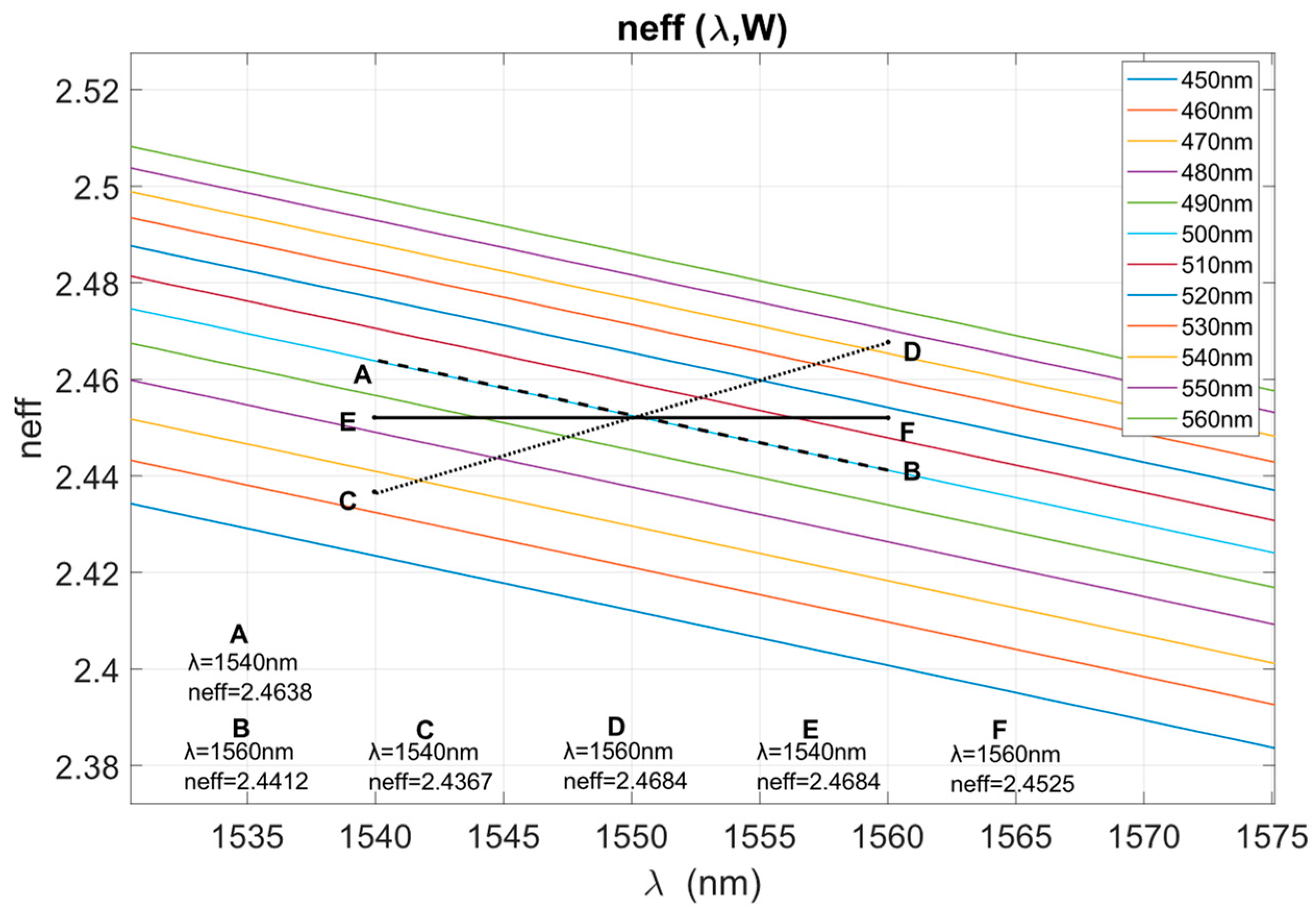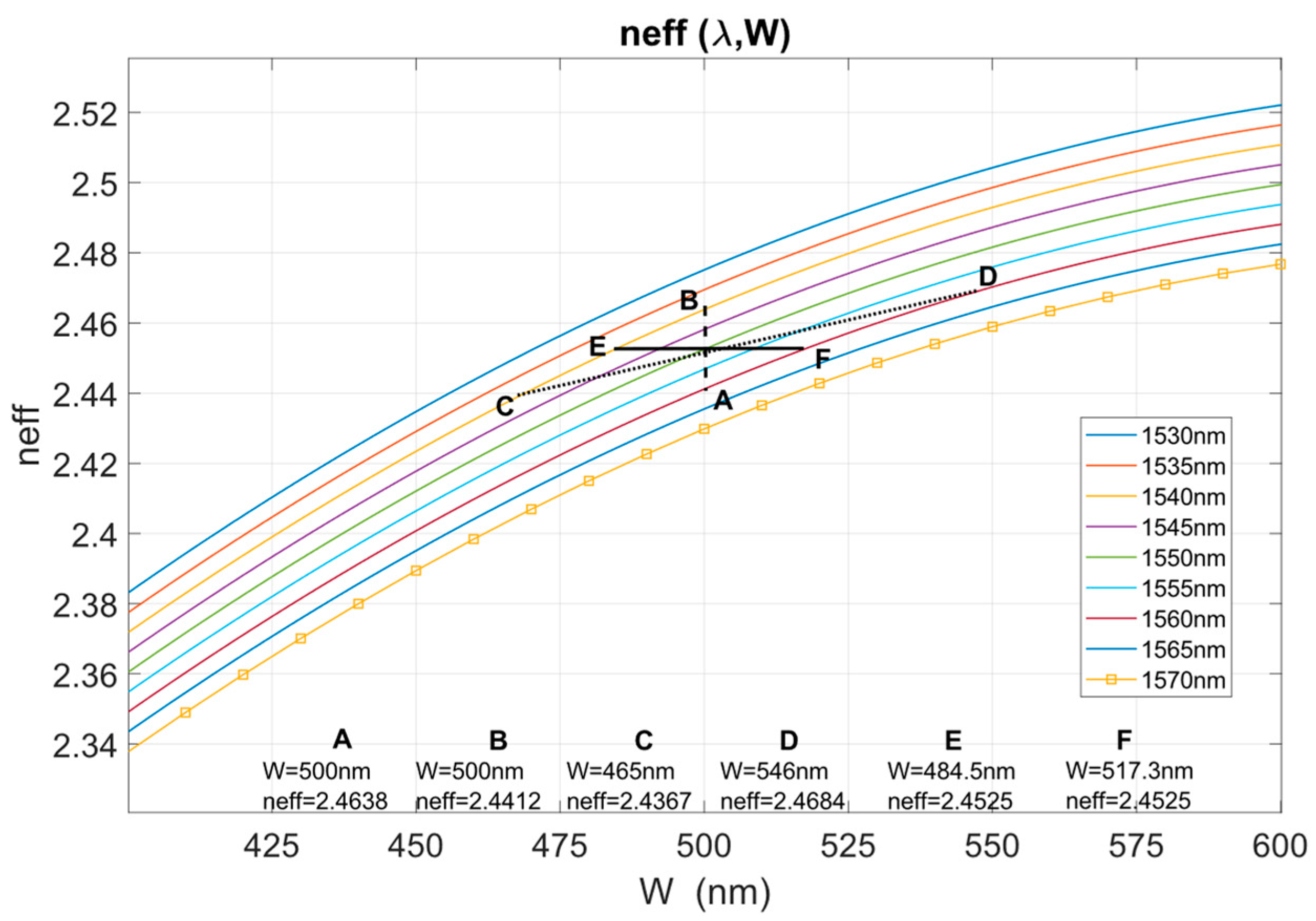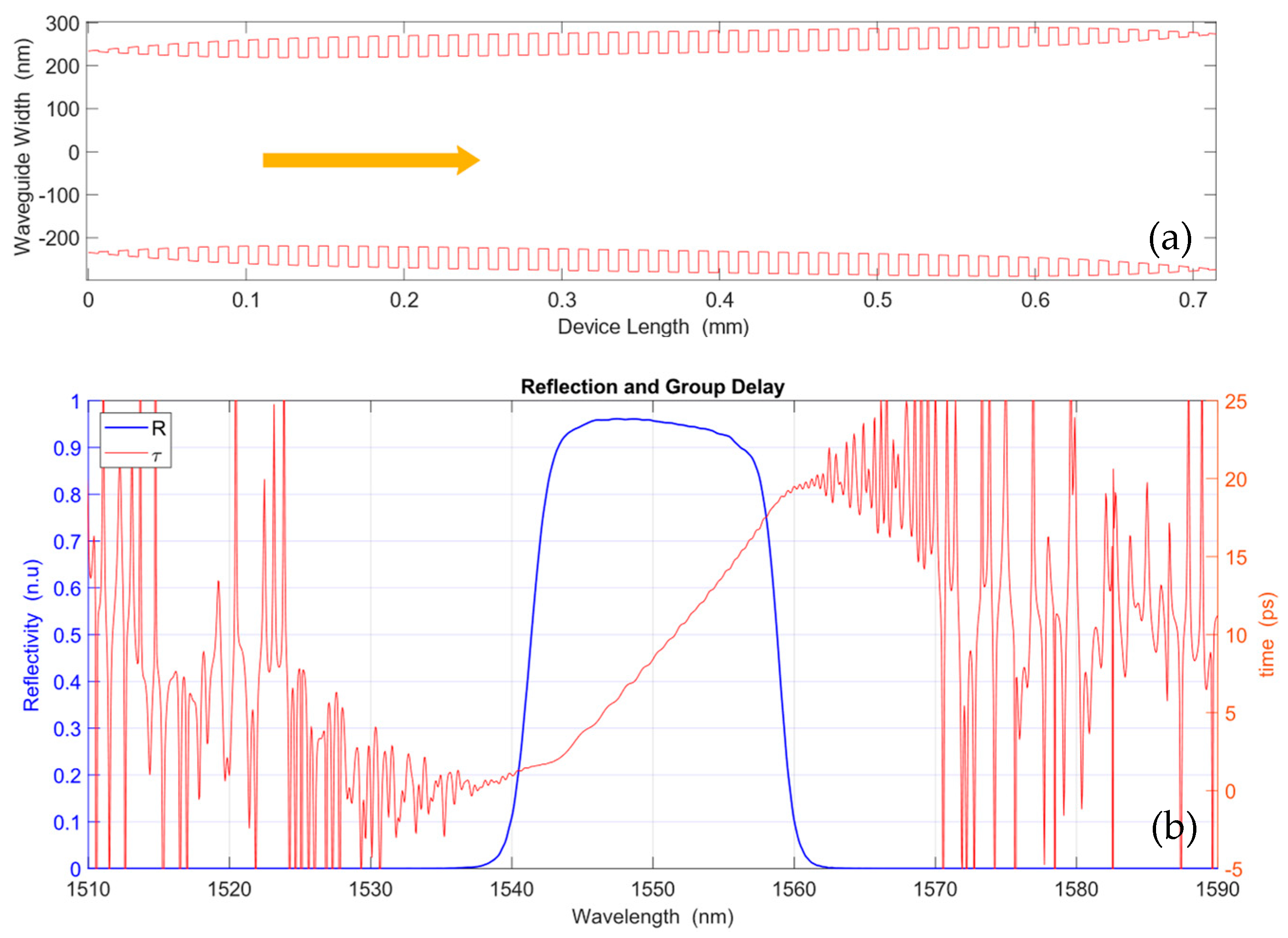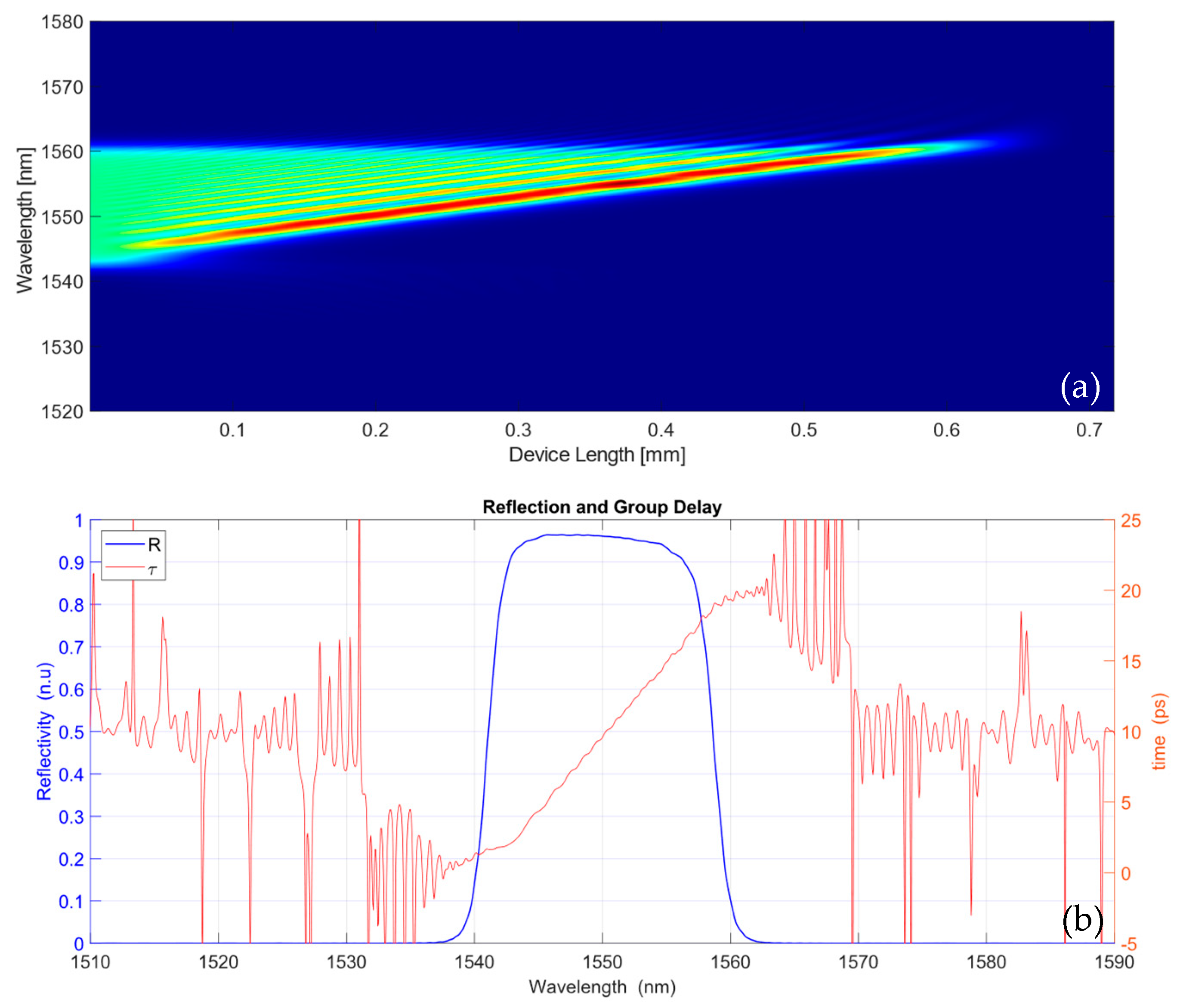Chirped Integrated Bragg Grating Design
Abstract
1. Introduction
2. Transfer Matrix Method Based on Effective Refractive Index
- Corrugation shape: defines the shape of the perturbation, which can generally be rectangular or sinusoidal (as shown in Figure 1a).
- Corrugation width, ΔW: the increase or decrease over the waveguide width (in the x-dimension), which represents the size of the perturbation.
- Bragg Period, ΛB: length of the sidewall modulation for the geometrical perturbation (in the z-axis), which corresponds to the periodical variation imposed on the effective refractive index. It is worth noting that the relation between ΛB, neff, and the Bragg wavelength, λB, is given by the Bragg condition [16]:
- Grating length, L: together with ΔW, it controls the intensity of the reflected field and the group delay for the chirped IBG.
2.1. Calculation of the Effective Refractive Index as a Function of Wavelength and Waveguide Width
2.2. Analysis of the IBG with the ERI–TMM
3. Designing Chirped IBG
- Spectrum bandwidth broadening. Following the Bragg condition, a linear variation in ΛB will produce a linear variation on λB, and therefore an effect of increasing the total reflected bandwidth as the sum of the bandwidths for each λB.
- Linear group delay (GD). Due to the fact that different Bragg wavelengths are reflected at different locations of the grating, λB(z), the time that every wavelength spends in the grating before achieving the phase-matching condition and gets reflected, is different and will determine the linear GD.
- Using Equation (1) to calculate the Bragg grating period for the wavelengths of the spectral interval around 1550 nm depending on the intended BW, or the neff needed for a particular central wavelength.
- Using the graphical representations (Figure 2 and Figure 3) of neff(λ,W) to determine the necessary width for a proposed neff, or the neff required for a given W, at the wavelengths of interest. As an alternative, an analytical calculation can be made by making a polynomial fit of the matrix N that defines neff(λ,W); however, for the sake of illustration, the graphical method is presented here.
- The length L of the IBG is estimated by evaluating the time it takes for the pulse to be reflected by the grating. This requires the use of the group index concept, which can be defined as the refractive index of the envelope of the optical pulse that propagates along the waveguide.
- Finally, ERI–TMM is applied to obtain the simulation results for reflectivity and group delay of the IBG.
- After checking the results, a fine adjustment can be made to the initial parameters in order to achieve a better transfer function, if necessary.
3.1. Chirp via Bragg Period Variation
3.2. Chirp via IBG Waveguide Width Variation
3.3. Chirp via IBG Bragg Grating Period and Waveguide Width Variation
4. Discussion
5. Conclusions
Author Contributions
Funding
Institutional Review Board Statement
Informed Consent Statement
Data Availability Statement
Conflicts of Interest
References
- Chrostowski, L.; Hochberg, M.E. Silicon Photonics Design: From Devices to System; Cambridge University Press: Cambridge, UK, 2015. [Google Scholar]
- Inniss, D.; Rubenstein, R. Silicon Photonics: Fueling the Next Information Revolution; Morgan Kaufmann: Cambridge, MA, USA, 2017. [Google Scholar]
- Passaro, V.M.N.; Loiacono, R.; D’Amico, G.; De Leonardis, F. Design of Bragg Grating Sensors Based on Submicrometer Optical Rib Waveguides in SOI. IEEE Sens. J. 2008, 8, 1603–1611. [Google Scholar] [CrossRef]
- Strain, M.J.; Thoms, S.; MacIntyre, D.S.; Sorel, M. Multi-Wavelength Filters in Silicon Using Superposition Sidewall Bragg Grating Devices. Opt. Lett. 2014, 39, 413–416. [Google Scholar] [CrossRef] [PubMed]
- Burla, M.; Cortés, L.R.; Li, M.; Wang, X.; Chrostowski, L.; Azaña, J. Integrated Waveguide Bragg Gratings for Microwave Photonics Signal Processing. Opt. Express 2013, 21, 25120–25147. [Google Scholar] [CrossRef]
- Sun, H.; Taglietti, B.; Wang, Y.; Chen, L.R. Integrated Subwavelength Grating Waveguide Bragg Gratings for Microwave Photonics. J. Light. Technol. 2022, 40, 6636–6649. [Google Scholar] [CrossRef]
- Anderson, S.R.; Begovic, A.; Huang, Z.R. Integrated Slow-Light Enhanced Silicon Photonic Modulators for RF Photonic Links. IEEE Photonics J. 2022, 14, 6647106. [Google Scholar] [CrossRef]
- Jafari, O.; Shi, W.; Larochelle, S. Mach-Zehnder Silicon Photonic Modulator Assisted by Phase-Shifted Bragg Gratings. IEEE Photonics Technol. Lett. 2020, 32, 445–448. [Google Scholar] [CrossRef]
- Li, Y.; Xu, L.; Wang, D.; Huang, Q.; Zhang, C.; Zhang, X. Large Group Delay and Low Loss Optical Delay Line Based on Chirped Waveguide Bragg Gratings. Opt. Express 2023, 31, 4630–4638. [Google Scholar] [CrossRef]
- Ma, M.; Chen, Z.; Yun, H.; Wang, Y.; Wang, X.; Jaeger, N.A.F.; Chrostowski, L. Apodized Spiral Bragg Grating Waveguides in Silicon-on-Insulator. IEEE Photonics Technol. Lett. 2018, 30, 111–114. [Google Scholar] [CrossRef]
- Ouellette, F. Dispersion Cancellation Using Linearly Chirped Bragg Grating Filters in Optical Waveguides. Opt. Lett. 1987, 12, 847–849. [Google Scholar] [CrossRef] [PubMed]
- Praena, J.A.; Carballar Rincón, A.C. Análisis y Caracterización de Bragg gratings integradas en tecnología Silicon-on-Insulator. In Libro de Actas OPTOEL 2023: Conectando la Academia y la Industria, 2024th ed; Universidad de Sevilla: Seville, Spain, 2023; Volume 90, pp. 129–134. [Google Scholar] [CrossRef]
- Rincón, A.C. Estudio de Redes de Difracción en Fibra Para su Aplicación en Comunicaciones Ópticas. Ph.D. Thesis, Universidad Politécnica de Madrid, Madrid, Spain, 1999. [Google Scholar] [CrossRef]
- Cheng, R.; Chrostowski, L. Spectral Design of Silicon Integrated Bragg Gratings: A Tutorial. J. Light. Technol. 2021, 39, 712–729. [Google Scholar] [CrossRef]
- KLayout. Available online: https://www.klayout.org (accessed on 1 June 2023).
- Erdogan, T. Fiber Grating Spectra. J. Light. Technol. 1997, 15, 1277–1294. [Google Scholar] [CrossRef]
- Lumerical. Copyright 2024 Ansys Canada Ltd. Available online: https://www.lumerical.com/ (accessed on 1 April 2023).
- Muriel, M.A.; Carballar, A.; Azana, J. Field Distributions inside Fiber Gratings. IEEE J. Quantum Electron. 1999, 35, 548–558. [Google Scholar] [CrossRef]
- Du, Z.; Xiang, C.; Fu, T.; Chen, M.; Yang, S.; Bowers, J.E.; Chen, H. Silicon Nitride Chirped Spiral Bragg Grating with Large Group Delay. APL Photonics 2020, 5, 101302. [Google Scholar] [CrossRef]
- Simard, A.D.; Painchaud, Y.; LaRochelle, S. Integrated Bragg Gratings in Spiral Waveguides. Opt. Express 2013, 21, 8953–8963. [Google Scholar] [CrossRef] [PubMed]
- Sinobad, M.; Lorenzen, J.; Wang, K.; Dijkstra, M.; Gaafar, M.A.; Herr, T.; Garcia-Blanco, S.M.; Singh, N.; Kärtner, F.X. C-Band Apodized Chirped Gratings in Aluminum Oxide Strip Waveguides. In Proceedings of the European Conference on Integrated Optics, Enschede, The Netherlands, 19–21 April 2023. [Google Scholar]
- Lu, Z.; Jhoja, J.; Klein, J.; Wang, X.; Liu, A.; Flueckiger, J.; Pond, J.; Chrostowski, L. Performance Prediction for Silicon Photonics Integrated Circuits with Layout-Dependent Correlated Manufacturing Variability. Opt. Express 2017, 25, 9712. [Google Scholar] [CrossRef]
- Cheng, R.; Han, Y.; Chrostowski, L. Characterization and Compensation of Apodization Phase Noise in Silicon Integrated Bragg Gratings. Opt. Express 2019, 27, 9516. [Google Scholar] [CrossRef] [PubMed]
- Wang, X. Silicon Photonic Waveguide Bragg Gratings. Ph.D. Thesis, The University of British Columbia, Vancouver, BC, Canada, 2013. [Google Scholar] [CrossRef]
- Cheng, R. Spectral Tailoring of Silicon Integrated Bragg Gratings. Ph.D. Thesis, The University of British Columbia, Vancouver, BC, Canada, 2020. [Google Scholar] [CrossRef]







Disclaimer/Publisher’s Note: The statements, opinions and data contained in all publications are solely those of the individual author(s) and contributor(s) and not of MDPI and/or the editor(s). MDPI and/or the editor(s) disclaim responsibility for any injury to people or property resulting from any ideas, methods, instructions or products referred to in the content. |
© 2024 by the authors. Licensee MDPI, Basel, Switzerland. This article is an open access article distributed under the terms and conditions of the Creative Commons Attribution (CC BY) license (https://creativecommons.org/licenses/by/4.0/).
Share and Cite
Praena, J.Á.; Carballar, A. Chirped Integrated Bragg Grating Design. Photonics 2024, 11, 476. https://doi.org/10.3390/photonics11050476
Praena JÁ, Carballar A. Chirped Integrated Bragg Grating Design. Photonics. 2024; 11(5):476. https://doi.org/10.3390/photonics11050476
Chicago/Turabian StylePraena, José Ángel, and Alejandro Carballar. 2024. "Chirped Integrated Bragg Grating Design" Photonics 11, no. 5: 476. https://doi.org/10.3390/photonics11050476
APA StylePraena, J. Á., & Carballar, A. (2024). Chirped Integrated Bragg Grating Design. Photonics, 11(5), 476. https://doi.org/10.3390/photonics11050476





